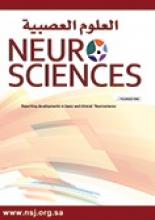Notice: Authors are encouraged to submit clinical images for possible publication in the Journal. These may be in any field of Clinical Neurosciences, and should approximately follow the format used here. Please address any submissions to the Assistant Editor, Neurosciences Journal, Prince Sultan Military Medical City, PO Box 7897, Riyadh 11159, Kingdom of Saudi Arabia. E-mail: malaskar{at}psmmc.med.sa
Joubert Syndrome
Clinical Presentation
You are evaluating a 3-year-old boy with developmental delay and ataxia. On examination, he is hypotonic. He has abnormal eye movement and abnormal breathing pattern. His brain MRI is shown in Figure 1.
Brain MRI of a 3-year-old boy with a history of developmental delay and ataxia.
Questions:
What is the most likely diagnosis:
Ataxia with oculomotor apraxia type I
Ataxia with oculomotor apraxia type II
Joubert syndrome
Leber congenital amaurosis
In which condition is a molar tooth seen on brain MRI?
Joubert syndrome
COACH syndrome
CORS syndrome
All of the above
Which of the following can be clinical abnormalities in Joubert Syndrome:
Neonatal hypotonia
Dysregulated breathing rhythms
Facial dysmorphisms
All of the above
Which of the following genes causing Joubert syndrome is noticed to be associated with retinal blindness and renal involvement?
CEP290
TMEM67
RPGRIP1L
None of the above
The overall risk of having renal disease in patients of Jeubert Syndrome:
3%
10%
15%
30%
Answers & Discussion
1. C)
Joubert syndrome is an autosomal recessive malformation of the brainstem and agenesis or hypoplasia of the cerebellar vermis. It presents with episodic hyperpnoea, abnormal eye movements, hypotonia, ataxia and mild to severe intellectual disability.4
2. (D)
Molar tooth sign (MTS) results from hypo-dysplasia of the cerebellar vermis, abnormally deep interpeduncular fossa at the level of the isthmus and upper pons, and horizontalized, thickened and elongated superior cerebellar peduncles. It was initially described in Joubert syndrome and related disorders (JSRD) but is now recognized to occur in a number of other conditions like nephronophthisis, cerebello-oculo-renal syndrome (CORS), COACH syndrome and Cogan’s syndrome.2
3. (A)
Genetic testing can predict disease severity. Mutations in certain genes causing Joubert syndrome, such as AHI1, INPP5E, CC2D2A, and ARL13B, can be detected in patients with MTS who do not have involvement of other organs, or they can be detected in patients with MTS together with retinal blindness. Mutations in TMEM216 and RPGRIP1L genes are often encountered in those patients with MTS and renal involvement. Mutations in CEP290 are encountered in half of patients with MTS together with retinal blindness and renal involvement. Mutations in TMEM67 are the most common cause of MTS with liver involvement. Thus, the specific gene mutation identified in a patient can help predict the range of organ involvement.3
4. (d)
The cardinal neurological features of Joubert Syndrome and Joubert Syndrome Related Disorders (JSRD) are hypotonia, altered respiratory pattern in the neonatal period and abnormal ocular movements. In general, the breathing abnormalities improve with age. Truncal ataxia develops over time and acquisition of gross motor milestones is delayed. Cognitive abilities are variable, ranging from severe intellectual disability to normal. Additional findings can include retinal dystrophy, renal disease, ocular colobomas, occipital encephalocele, hepatic fibrosis, polydactyly, oral hamartomas, and endocrine abnormalities. Both intra- and interfamilial variation are seen.1
5. (D)
Renal disease is reported in 25-30% of patients with JS varying from chronic tubulointerstitial nephropathy in the form of juvenile nephronophthisis to nephrocystic disease which is clinically and morphologically similar to autosomal recessive polycystic kidney disease. Acute or chronic renal insufficiency manifests either late in the first decade of life or early in the second. End stage renal failure is usually reached by the end of the second decade, requiring dialysis or kidney transplantation.1
- Copyright: © Neurosciences
Neurosciences is an Open Access journal and articles published are distributed under the terms of the Creative Commons Attribution-NonCommercial License (CC BY-NC). Readers may copy, distribute, and display the work for non-commercial purposes with the proper citation of the original work.







